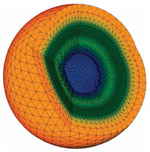Department of Physics and Astronomy: Publications and Other Research
Date of this Version
1-2-2020
Document Type
Article
Citation
PHYSICAL REVIEW B 101, 014402 (2020)
DOI: 10.1103/PhysRevB.101.014402
Abstract
The amorphous iron-germanium system (a-FexGe1-x) lacks long-range structural order and hence lacks a meaningful Brillouin zone. The magnetization of a-FexGe1-x is well explained by the Stoner model for Fe concentrations x above the onset of magnetic order around x=0.4, indicating that the local order of the amorphous structure preserves the spin-split density of states of the Fe-3d states sufficiently to polarize the electronic structure despite k being a bad quantum number. Measurements reveal an enhanced anomalous Hall resistivity ρxyAH relative to crystalline FeGe; this ρxyAH is compared to density-functional theory calculations of the anomalous Hall conductivity to resolve its underlying mechanisms. The intrinsic mechanism, typically understood as the Berry curvature integrated over occupied k states but shown here to be equivalent to the density of curvature integrated over occupied energies in aperiodic materials, dominates the anomalous Hall conductivity of a-FexGe1-x (0.38≤x≤0.61). The density of curvature is the sum of spin-orbit correlations of local orbital states and can hence be calculated with no reference to k space. This result and the accompanying Stoner-like model for the intrinsic anomalous Hall conductivity establish a unified understanding of the underlying physics of the anomalous Hall effect in both crystalline and disordered systems.
Included in
Atomic, Molecular and Optical Physics Commons, Condensed Matter Physics Commons, Other Physics Commons


Comments
©2020 American Physical Society. Used by permission.